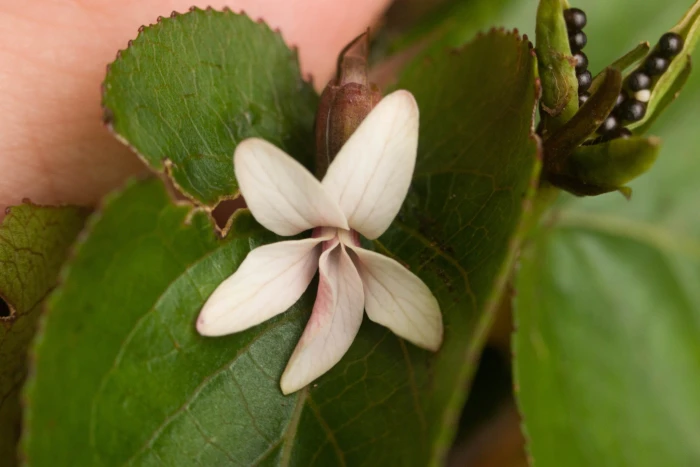’Olopu
(Viola chamissoniana)
’Olopu (Viola chamissoniana)
/
/

© Kevin Faccenda
CC BY 4.0
Image By:
© Kevin Faccenda
Recorded By:
Copyright:
CC BY 4.0
Copyright Notice:
Photo by: © Kevin Faccenda | License Type: CC BY 4.0 | License URL: http://creativecommons.org/licenses/by/4.0/ | Uploader: kevinfaccenda | Publisher: iNaturalist |



































Estimated Native Range
Climate Requirements for Fairfax, Virginia
| This Plant | Your Site | Plant Suitability for Your Location | ||
|---|---|---|---|---|
| • Precipitation | 34" - 126" | 41" | Aquatic | Aquatic |
| • High Temp. | 75°F - 87°F | 88°F | Your summers may be too hot for this plant. | Too hot |
| • Low Temp. | 53°F - 62°F | 25°F | Your winter temperatures may be too cold for this plant | Too cold |
This plant should grow well at your location with about N inches per year (Y minutes per month) of irrigation.
Summary
Viola chamissoniana, commonly known as ’olopu, is a perennial woody shrub endemic to the Hawaiian Islands, specifically found in moist and wet forests on Kauai, Oahu, Molokai, and Maui. It is a rare species that grows from a taproot and can root adventitiously where the lower stem contacts the substrate. The leaves of ’olopu can reach up to 11 inches long and have toothed edges. From spring to summer, it produces purple-tinged white flowers that are modest in size but notable for their unique coloration. The fruit is a dry capsule that splits open to release small, dark seeds. The subspecies chamissoniana, limited to the Waianae Range on Oahu, is federally listed as endangered, with approximately 443 individuals remaining. Threats to its survival include predation by feral goats and competition with invasive plant species.
’Olopu is not commonly cultivated due to its rarity and conservation status. However, it may have potential in native plant restoration projects and botanical gardens focused on preserving Hawaiian flora. In cultivation, it would require conditions that mimic its native moist forest habitat, including well-draining soil, consistent moisture, and partial to full shade. Its unique flowers and foliage could provide ornamental value in such settings. Due to its endangered status, any cultivation should be done responsibly and preferably under the guidance of conservation programs.CC BY-SA 4.0
’Olopu is not commonly cultivated due to its rarity and conservation status. However, it may have potential in native plant restoration projects and botanical gardens focused on preserving Hawaiian flora. In cultivation, it would require conditions that mimic its native moist forest habitat, including well-draining soil, consistent moisture, and partial to full shade. Its unique flowers and foliage could provide ornamental value in such settings. Due to its endangered status, any cultivation should be done responsibly and preferably under the guidance of conservation programs.CC BY-SA 4.0
Plant Description
- Plant Type: Shrub, Herb
- Height: 0.5-1 feet
- Width: 0.5-1 feet
- Growth Rate: Moderate
- Flower Color: Purple, White
- Flowering Season: Spring, Summer, Fall
- Leaf Retention: Evergreen
Growth Requirements
- Sun: Part Shade
- Water: Medium
- Drainage: Medium
Common Uses
Border Plant, Butterfly Garden, Low Maintenance, Water Garden
Natural Habitat
Moist and wet forests on Kauai, Oahu, Molokai, and Maui
Other Names
Common Names: Chamisso’s Violet, Pāmakani, Manoa Stream Violet
Scientific Names: Viola chamissoniana, Viola chamissoniana var. olokelensis, Viola helioscopia, Viola robusta var. mauiensis, Viola tracheliifolia f. tomentosa, Viola tracheliifolia var. olokelensis, Viola tracheliifolia var. populifolia, Viola tracheliifolia var. tomentosa
GBIF Accepted Name: Viola chamissoniana